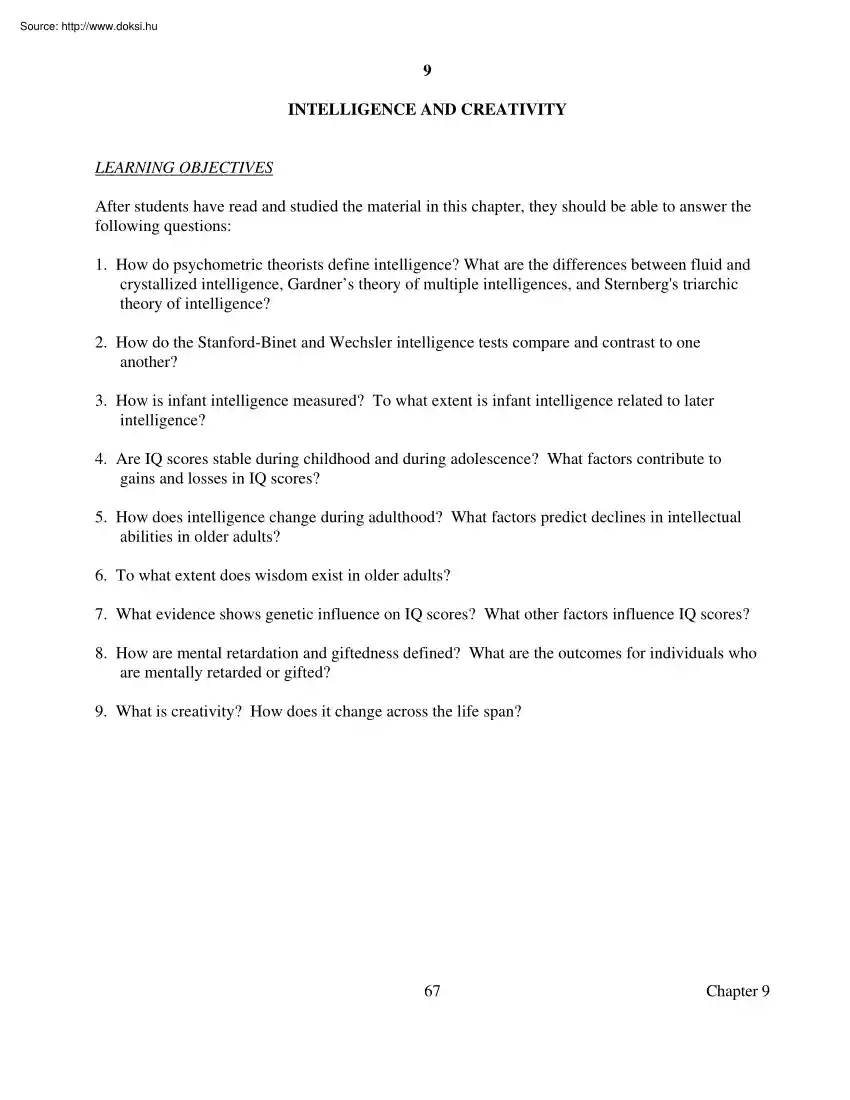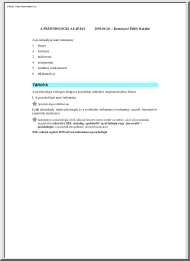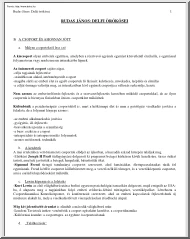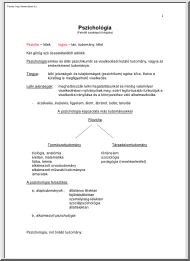Datasheet
Year, pagecount:2005, 7 page(s)
Language:English
Downloads:11
Uploaded:April 28, 2013
Size:36 KB
Institution:
-
Comments:
Attachment:-
Download in PDF:Please log in!
Comments
No comments yet. You can be the first!Most popular documents in this category
Content extract
9 INTELLIGENCE AND CREATIVITY LEARNING OBJECTIVES After students have read and studied the material in this chapter, they should be able to answer the following questions: 1. How do psychometric theorists define intelligence? What are the differences between fluid and crystallized intelligence, Gardner’s theory of multiple intelligences, and Sternbergs triarchic theory of intelligence? 2. How do the Stanford-Binet and Wechsler intelligence tests compare and contrast to one another? 3. How is infant intelligence measured? To what extent is infant intelligence related to later intelligence? 4. Are IQ scores stable during childhood and during adolescence? What factors contribute to gains and losses in IQ scores? 5. How does intelligence change during adulthood? What factors predict declines in intellectual abilities in older adults? 6. To what extent does wisdom exist in older adults? 7. What evidence shows genetic influence on IQ scores? What other factors influence IQ scores? 8. How
are mental retardation and giftedness defined? What are the outcomes for individuals who are mentally retarded or gifted? 9. What is creativity? How does it change across the life span? 67 Chapter 9 CHAPTER OUTLINE I. What is intelligence? Piaget-- focus on universal stages of cognitive development Information-processing-- focus on basic cognitive processes in all people A. The psychometric approach-- focus on measurement of intelligence (defined as set of Traits that characterize individual) 1. A single attribute or many attributes? a. factor analysis-- identifies clusters (factors) of highly correlated items b. Spearman-- intelligence equals general mental ability (g) plus special abilities (s) c. Thurstone-- seven primary mental abilities underlie intelligence i. spatial ability ii. perceptual speed iii. numerical reasoning iv. verbal meaning v. word fluency vi. memory vii. inductive reasoning d. Guilford’s structure-of-intellect model-- three elements of intelligence i.
contents-- what you can think about ii. operations-- actions that can be performed on contents iii. products-- outcomes of thinking 2. Fluid versus crystallized intelligence a. Cattell and Horns work b. fluid intelligence-- use mind actively to solve problem c. crystallized intelligence-- use of knowledge acquired through experience d. emphasis on intelligence tests that summarize intellect into a single score B. Gardner’s theory of multiple intelligences 1. Eight distinct kinds of intelligences a. linguistic-- language skills b. logical-mathematical-- abstract thinking c. musical-- sensitivity to sound patterns d. spatial-- object perception e. bodily-kinesthetic-- body movement skills f. interpersonal-- social skills g. intrapersonal-- understanding one’s own feeling h. naturalistic-- world of plants and animals 2. Savant syndrome-- extraordinary talent in a mentally retarded person C. Sternbergs triarchic theory-- three aspects of intellectual behavior 1. Contextual component--
real-world adaptation versus test-taking a. intelligence defined by culture 2. Experiential component-- impact of experience a. response to novelty b. automatization-- increased efficiency c. cultural bias-- familiarity of items varies by culture Chapter 9 68 3. Information-processing component a. focus on cognitive components underlying intelligence II. How is intelligence measured? A. The Stanford-Binet test 1. Alfred Binet and Theodore Simon a. 1904 test to identify French children who might struggle in school b. description of childs mental age (MA) with age-graded test items c. Lewis Terman produces Stanford-Binet Intelligence Test (1916) 2. Intelligence quotient-- IQ = Mental Age/Chronological Age x 100 3. Test norms-- standards of typical performance B. The Wechsler scalesDavid Wechsler’s intelligence tests across the life span 1. Wechsler Preschool and Primary Scale of Intelligence (WPPSI) 2. Wechsler Intelligence Scale for Children (WISC) 3. Wechsler Adult
Intelligence Scale (WAIS) 4. Generate verbal, performance, and full-scale IQ scores C. The distribution of IQ scores 1. Normal distribution-- bell-shaped spread around average score 2. Average IQ score is 100 D. Intelligence testing today 1. Dynamic assessmentassessment of potential to learn new material a. Feuersteins Learning Potential Assessment Device-- assesses the ability to learn new things quickly with minimal guidance b. Cognitive Assessment Systemassesses for cognitive processes i. planning a solution ii. attending to relevant information iii. simultaneous processing iv. processing in specific order 2. Use of IQ scores criticized a. one point score not necessarily predictive III. The infant A. Developmental Quotients-- intelligence tests used on young children 1. Bayley Scales of Infant Development (2-30 months) a. motor scale, mental scale, infant behavioral record b. developmental quotient (DQ)-- performance compared to norms B. Infant intelligence and later intelligence
1. Low correlation between DQ scores and later IQ scores 2. Explanations for this lack of relationship a. Each assesses different domains b. Infant intelligence based on universal maturation 3. Relationship between measures of infant attention and later IQ a. Speed of habituation, preference for novelty, reaction time IV. The child A. How stable are IQ scores during childhood? 69 Chapter 9 V. VI. 1. IQ scores are fairly stable starting at about age 4 a. high short-term predictability 2. Correlations reflect groups of children, not individuals a. within group stability but individual variation B. Causes of gains and losses 1. Fluctuation greatest if child in unstable environment 2. Cumulative-deficit hypothesis-- IQ scores of children from impoverished environments decrease as negative effects accumulate The adolescent A. Continuity between childhood and adulthood 1. Rapid intellectual growth in early adolescence, then levels off a. growth may be due to brain development 2.
Increasing stability of individual differences B. IQ and school achievement 1. IQ is good predictor of academic achievement, especially high school (versus college) The adult A. IQ and occupational success 1. Some occupations require more intellectual ability than others 2. Performance on the job also related to IQ 3. Motivation and environmental factors also play role B. Change in IQ with age 1. Depends on type of research design a. cross-sectional design-- decline in later life (Kaufman) b. longitudinal design-- some decline in later life (Kaufman) c. sequential design-- young cohorts outscore older cohorts, scores vary by type of intelligence measured (Schaie) i. fluid (skills to solve novel problems) shows decline ii. crystallized (general knowledge) shows increase 2. Cohort effects on performance 3. Declines occur fairly late in life-- 60s or 70s a. performance on speeded tests declines more b. more declines in performance than in verbal intelligence 4. Patterns of aging differ
for different abilities 5. Declines are not universal C. Predictors of decline 1. Poor health a. terminal drop-- rapid loss of IQ within a few years of death 2. Unstimulating lifestyle a. disengagement has negative impact on intellect b. “use it or lose it!” D. Potential for Wisdom 1. Wisdom-- expert knowledge in fundamental pragmatic of life a. factual knowledge b. procedural knowledge Chapter 9 70 c. life-span contextual perspective d. relativism of values and life priorities e. recognition and management of uncertainty 2. Related more to expertise than age 3. Research does not yet support common belief of wisdom in old age 4. Combination of intelligence, personality, and cognitive style VII. Factors that influence IQ scores A. Genes 1. Identical twins IQ scores more similar than fraternal IQ scores 2. Adopted children’s IQ more similar to biological parents than adoptive parent 3. Can be influenced by non-genetic factors (eg, nutrition) B. Home environment 1.
Environmental risk factors predict lower IQ scores 2. HOME inventory developed by Caldwell and Bradley assess various aspects of environment a. emotional and verbal responsivity of parent b. avoidance of restriction and punishment c. organization of physical and temporal environment d. provision of appropriate play material e. parental involvement with child f. opportunities for variety in daily stimulation 3. Intelligent parents may provide better environment 4. gene/environment interaction a key C. Family size and birth order 1. Birth order thought to highly influence development a. research dilution model (only so many resources to go around) b. research data on birth order effect mixed 2. Family size may be predictor (larger family-less intelligence) a. cannot tell why (cause-effect?) D. Social-class differences 1. Flynn effect-- 20th century increases in IQ 2. Adoption from lower-class into middle-class homes associated with higher IQ 3. Social class differences may reflect poorer
home environment provided by parents E. Racial and ethnic differences 1. Authors of The Bell Curve argue for genetic basis for racial differences in intelligence 2. Some racial and ethnic difference in IQ scores do exist but could be do to several factors 3. Culture bias-- possible bias in test questions a. may favor white middle-class students b. culture-fair IQ tests included familiar and unfamiliar items c. IQ scores predict school success for most populations 4. Motivational factors-- students not trying a. may be do to anxiety/resistance to judgment by whites 71 Chapter 9 b. negative stereotypes may decrease scores c. test score can be improved by giving student more time d. if student believes they will be judged scores may be lower e. positive stereotypes may increase scores 5. Genetic influences a. heated debate in psychology b. within group differences cannot be equate to between-group differences c. no direct evidence that race differences in test scores due to genetics
6. Environmental influences a. adoption research supports critical impact of environment b. intellectually stimulating environment a key c. exposure to “culture of tests” critical d. IQ gap between blacks and whites may be decreasing VIII. The extremes of intelligence A. Mental retardation 1. IQ score below 70-75 and limitations in meeting age-appropriate expectations 2. Impact can range from mild to profound a. mild-- IQ about 52 to 75, usually independent b. moderate-- Q about 35 to 51, need some supervision c. severe-- IQ about 20 to 35, close supervision d. profound-- IQ below 19, dependent and needs constant supervision 3. Causes are organic retardation or cultural-familial retardation a. organic-- due to biological cause (heredity, disease, injury) i. Down syndrome-- extra 21st chromosome ii. phenylkentinuria (PKU) iii. maternal alcohol consumption b. cultural-familial-- combination of low genetic potential and poor environment 4. Can be later life deterioration of intellect
5. May do better than stereotypic expectations of others B. Giftedness 1. High IQ or special abilities in areas valued by society 2. Renzulli states giftedness combination of above-average ability, creativity, and task commitment 3. Gottfried’s research a. identified potentially gifted children at age 18 months b. gifted children tend to have similar characteristics like: extensive vocabulary, rapid learning, good memory, longer attention span 4. Terman’s research a. study of 1500 gifted children begun in 1921 b. intellectually gifted children also better adjusted, better-than-average health, earlier puberty c. destroyed stereotype of intellectuals as weak and frail d. achievement and mental health lasted into adulthood e. “Termites” were successful into old age Chapter 9 72 IX. Creativity and special talents A. What is creativity? 1. Creativity-- ability to produce novel, appropriate, and valued responses 2. Divergent thinking-- variety of solutions when there is no one
correct answer 3. Convergent thinking-- finding the one “best” answer 4. Ideational fluency-- number of different ideas one can generate 5. Creativity and IQ not highly correlated B. Creativity in childhood and adolescence 1. Influenced by different factors than IQ 2. Genetic factors do not appear to impact creativity 3. Developmental course of creativity less predictable a. preschool children highly original b. age of creativity highly variable c. tests may predict creative accomplishments 4. Talent and motivation both important 5. Must become intimately familiar with current state of field 6. Impact of nurture (environment) may be underrated C. Creative achievement in adulthood 1. Relationship between age and creative achievement depends on field 2. Creative production usually greatest from 20s to early 40s in most fields 3. Creative behavior possible, but less frequent in later life 4. Simonton suggests creativity requires both ideation and elaboration a. ideation-- generating
creative ideas b. elaboration-- executing ideas to real problems c. older people may use up stock of potential ideas 73 Chapter 9
are mental retardation and giftedness defined? What are the outcomes for individuals who are mentally retarded or gifted? 9. What is creativity? How does it change across the life span? 67 Chapter 9 CHAPTER OUTLINE I. What is intelligence? Piaget-- focus on universal stages of cognitive development Information-processing-- focus on basic cognitive processes in all people A. The psychometric approach-- focus on measurement of intelligence (defined as set of Traits that characterize individual) 1. A single attribute or many attributes? a. factor analysis-- identifies clusters (factors) of highly correlated items b. Spearman-- intelligence equals general mental ability (g) plus special abilities (s) c. Thurstone-- seven primary mental abilities underlie intelligence i. spatial ability ii. perceptual speed iii. numerical reasoning iv. verbal meaning v. word fluency vi. memory vii. inductive reasoning d. Guilford’s structure-of-intellect model-- three elements of intelligence i.
contents-- what you can think about ii. operations-- actions that can be performed on contents iii. products-- outcomes of thinking 2. Fluid versus crystallized intelligence a. Cattell and Horns work b. fluid intelligence-- use mind actively to solve problem c. crystallized intelligence-- use of knowledge acquired through experience d. emphasis on intelligence tests that summarize intellect into a single score B. Gardner’s theory of multiple intelligences 1. Eight distinct kinds of intelligences a. linguistic-- language skills b. logical-mathematical-- abstract thinking c. musical-- sensitivity to sound patterns d. spatial-- object perception e. bodily-kinesthetic-- body movement skills f. interpersonal-- social skills g. intrapersonal-- understanding one’s own feeling h. naturalistic-- world of plants and animals 2. Savant syndrome-- extraordinary talent in a mentally retarded person C. Sternbergs triarchic theory-- three aspects of intellectual behavior 1. Contextual component--
real-world adaptation versus test-taking a. intelligence defined by culture 2. Experiential component-- impact of experience a. response to novelty b. automatization-- increased efficiency c. cultural bias-- familiarity of items varies by culture Chapter 9 68 3. Information-processing component a. focus on cognitive components underlying intelligence II. How is intelligence measured? A. The Stanford-Binet test 1. Alfred Binet and Theodore Simon a. 1904 test to identify French children who might struggle in school b. description of childs mental age (MA) with age-graded test items c. Lewis Terman produces Stanford-Binet Intelligence Test (1916) 2. Intelligence quotient-- IQ = Mental Age/Chronological Age x 100 3. Test norms-- standards of typical performance B. The Wechsler scalesDavid Wechsler’s intelligence tests across the life span 1. Wechsler Preschool and Primary Scale of Intelligence (WPPSI) 2. Wechsler Intelligence Scale for Children (WISC) 3. Wechsler Adult
Intelligence Scale (WAIS) 4. Generate verbal, performance, and full-scale IQ scores C. The distribution of IQ scores 1. Normal distribution-- bell-shaped spread around average score 2. Average IQ score is 100 D. Intelligence testing today 1. Dynamic assessmentassessment of potential to learn new material a. Feuersteins Learning Potential Assessment Device-- assesses the ability to learn new things quickly with minimal guidance b. Cognitive Assessment Systemassesses for cognitive processes i. planning a solution ii. attending to relevant information iii. simultaneous processing iv. processing in specific order 2. Use of IQ scores criticized a. one point score not necessarily predictive III. The infant A. Developmental Quotients-- intelligence tests used on young children 1. Bayley Scales of Infant Development (2-30 months) a. motor scale, mental scale, infant behavioral record b. developmental quotient (DQ)-- performance compared to norms B. Infant intelligence and later intelligence
1. Low correlation between DQ scores and later IQ scores 2. Explanations for this lack of relationship a. Each assesses different domains b. Infant intelligence based on universal maturation 3. Relationship between measures of infant attention and later IQ a. Speed of habituation, preference for novelty, reaction time IV. The child A. How stable are IQ scores during childhood? 69 Chapter 9 V. VI. 1. IQ scores are fairly stable starting at about age 4 a. high short-term predictability 2. Correlations reflect groups of children, not individuals a. within group stability but individual variation B. Causes of gains and losses 1. Fluctuation greatest if child in unstable environment 2. Cumulative-deficit hypothesis-- IQ scores of children from impoverished environments decrease as negative effects accumulate The adolescent A. Continuity between childhood and adulthood 1. Rapid intellectual growth in early adolescence, then levels off a. growth may be due to brain development 2.
Increasing stability of individual differences B. IQ and school achievement 1. IQ is good predictor of academic achievement, especially high school (versus college) The adult A. IQ and occupational success 1. Some occupations require more intellectual ability than others 2. Performance on the job also related to IQ 3. Motivation and environmental factors also play role B. Change in IQ with age 1. Depends on type of research design a. cross-sectional design-- decline in later life (Kaufman) b. longitudinal design-- some decline in later life (Kaufman) c. sequential design-- young cohorts outscore older cohorts, scores vary by type of intelligence measured (Schaie) i. fluid (skills to solve novel problems) shows decline ii. crystallized (general knowledge) shows increase 2. Cohort effects on performance 3. Declines occur fairly late in life-- 60s or 70s a. performance on speeded tests declines more b. more declines in performance than in verbal intelligence 4. Patterns of aging differ
for different abilities 5. Declines are not universal C. Predictors of decline 1. Poor health a. terminal drop-- rapid loss of IQ within a few years of death 2. Unstimulating lifestyle a. disengagement has negative impact on intellect b. “use it or lose it!” D. Potential for Wisdom 1. Wisdom-- expert knowledge in fundamental pragmatic of life a. factual knowledge b. procedural knowledge Chapter 9 70 c. life-span contextual perspective d. relativism of values and life priorities e. recognition and management of uncertainty 2. Related more to expertise than age 3. Research does not yet support common belief of wisdom in old age 4. Combination of intelligence, personality, and cognitive style VII. Factors that influence IQ scores A. Genes 1. Identical twins IQ scores more similar than fraternal IQ scores 2. Adopted children’s IQ more similar to biological parents than adoptive parent 3. Can be influenced by non-genetic factors (eg, nutrition) B. Home environment 1.
Environmental risk factors predict lower IQ scores 2. HOME inventory developed by Caldwell and Bradley assess various aspects of environment a. emotional and verbal responsivity of parent b. avoidance of restriction and punishment c. organization of physical and temporal environment d. provision of appropriate play material e. parental involvement with child f. opportunities for variety in daily stimulation 3. Intelligent parents may provide better environment 4. gene/environment interaction a key C. Family size and birth order 1. Birth order thought to highly influence development a. research dilution model (only so many resources to go around) b. research data on birth order effect mixed 2. Family size may be predictor (larger family-less intelligence) a. cannot tell why (cause-effect?) D. Social-class differences 1. Flynn effect-- 20th century increases in IQ 2. Adoption from lower-class into middle-class homes associated with higher IQ 3. Social class differences may reflect poorer
home environment provided by parents E. Racial and ethnic differences 1. Authors of The Bell Curve argue for genetic basis for racial differences in intelligence 2. Some racial and ethnic difference in IQ scores do exist but could be do to several factors 3. Culture bias-- possible bias in test questions a. may favor white middle-class students b. culture-fair IQ tests included familiar and unfamiliar items c. IQ scores predict school success for most populations 4. Motivational factors-- students not trying a. may be do to anxiety/resistance to judgment by whites 71 Chapter 9 b. negative stereotypes may decrease scores c. test score can be improved by giving student more time d. if student believes they will be judged scores may be lower e. positive stereotypes may increase scores 5. Genetic influences a. heated debate in psychology b. within group differences cannot be equate to between-group differences c. no direct evidence that race differences in test scores due to genetics
6. Environmental influences a. adoption research supports critical impact of environment b. intellectually stimulating environment a key c. exposure to “culture of tests” critical d. IQ gap between blacks and whites may be decreasing VIII. The extremes of intelligence A. Mental retardation 1. IQ score below 70-75 and limitations in meeting age-appropriate expectations 2. Impact can range from mild to profound a. mild-- IQ about 52 to 75, usually independent b. moderate-- Q about 35 to 51, need some supervision c. severe-- IQ about 20 to 35, close supervision d. profound-- IQ below 19, dependent and needs constant supervision 3. Causes are organic retardation or cultural-familial retardation a. organic-- due to biological cause (heredity, disease, injury) i. Down syndrome-- extra 21st chromosome ii. phenylkentinuria (PKU) iii. maternal alcohol consumption b. cultural-familial-- combination of low genetic potential and poor environment 4. Can be later life deterioration of intellect
5. May do better than stereotypic expectations of others B. Giftedness 1. High IQ or special abilities in areas valued by society 2. Renzulli states giftedness combination of above-average ability, creativity, and task commitment 3. Gottfried’s research a. identified potentially gifted children at age 18 months b. gifted children tend to have similar characteristics like: extensive vocabulary, rapid learning, good memory, longer attention span 4. Terman’s research a. study of 1500 gifted children begun in 1921 b. intellectually gifted children also better adjusted, better-than-average health, earlier puberty c. destroyed stereotype of intellectuals as weak and frail d. achievement and mental health lasted into adulthood e. “Termites” were successful into old age Chapter 9 72 IX. Creativity and special talents A. What is creativity? 1. Creativity-- ability to produce novel, appropriate, and valued responses 2. Divergent thinking-- variety of solutions when there is no one
correct answer 3. Convergent thinking-- finding the one “best” answer 4. Ideational fluency-- number of different ideas one can generate 5. Creativity and IQ not highly correlated B. Creativity in childhood and adolescence 1. Influenced by different factors than IQ 2. Genetic factors do not appear to impact creativity 3. Developmental course of creativity less predictable a. preschool children highly original b. age of creativity highly variable c. tests may predict creative accomplishments 4. Talent and motivation both important 5. Must become intimately familiar with current state of field 6. Impact of nurture (environment) may be underrated C. Creative achievement in adulthood 1. Relationship between age and creative achievement depends on field 2. Creative production usually greatest from 20s to early 40s in most fields 3. Creative behavior possible, but less frequent in later life 4. Simonton suggests creativity requires both ideation and elaboration a. ideation-- generating
creative ideas b. elaboration-- executing ideas to real problems c. older people may use up stock of potential ideas 73 Chapter 9





 When reading, most of us just let a story wash over us, getting lost in the world of the book rather than paying attention to the individual elements of the plot or writing. However, in English class, our teachers ask us to look at the mechanics of the writing.
When reading, most of us just let a story wash over us, getting lost in the world of the book rather than paying attention to the individual elements of the plot or writing. However, in English class, our teachers ask us to look at the mechanics of the writing.